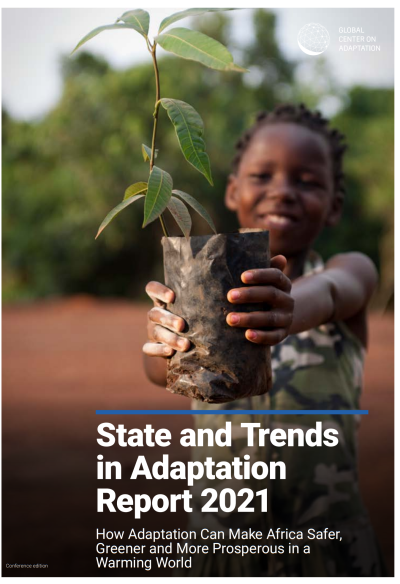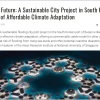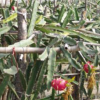Introduction
Natural ecosystems and all human activity – subsistence and capital formation, habitation and migration, agriculture and fishing, transport, energy production, water supply and sanitation – are deeply reliant on water. However, there is no discussion of climate change impacts and adaptation, therefore, that does not touch upon water related issues.
One of the most direct channels of transmission of climate change is through its impact on rainfall: too much, too little, at unexpected times, and in ways that are harder to predict or manage. Such changes, in turn, can alter land-use patterns because of desertification and flooding, affect the kinds of crops that can be grown in different habitats, impact the water flows of river basins, and living standards of entire nations; and expose vulnerable populations living in flood-prone areas to extreme levels of distress and risk. Changes in land use have long altered water flows, flows on land and as rainfall, and climate change exacerbate these trends.
This is especially true of Africa, which finds itself today on the front lines of climate change. As in other parts of the world, the number of extreme weather events – both floods and droughts – has increased in Africa in recent years. At least in the near term, climate change is locked in, so the worst is yet to come. The combination of higher seas and stronger storms created by climate change will mean that today's 1-in-100-year coastal flooding events will happen once every 10 to 20 years by mid-century, threatening millions of people in coastal communities. Productivity growth for the continent's number one staple, maize, has stalled, and the likelihood of conflict has increased. Cumulatively, these developments threaten to arrest and even reverse decades of hard-won economic progress in Africa.
How can Africa respond swiftly and strategically to its changing water challenges? Using a combination of expert viewpoints, case studies, and data from the field, a recent report by the Global Center on Adaptation (GCA) provides an insight into the current state and prospects of water-related resilience in Africa, and lays out a detailed blueprint for water-resource management.
For instance, the report shows how adaptation can be up-scaled into a key element of flood risk reduction in Africa. Floods are a major area of vulnerability in Africa today. The number of floods in Africa has increased five-fold since the 1990s. Over the period 2008–2018, floods accounted for 65 percent of disaster events in Africa and caused 24 percent of disaster-related deaths. Countries with a high share of the population exposed to floods include Egypt, Sudan, the Central African Republic, Somalia, and Mali.
Not only are floods immensely destructive of lives and livelihoods, but they also have a disproportionate impact on the lives of the poor, who typically live in lower-quality housing and rely on climate-dependent agricultural systems for food and income. Moreover, the timing and scale of floods can be hard to predict, and traditional flood risk-reduction infrastructure, while effective, is expensive and requires careful targeting.
It follows, then, that much greater emphasis must now be laid on adaptation as a cost-effective, multidimensional, and practicable form of water management that incorporates flood risk management. For instance, integrating nature-based solutions (NbS) into conventional water system infrastructure planning is a form of adaptation at its most proactive.
Green roofs, urban parks, wetlands, forests, and other nature-based approaches can significantly improve storm-water management and reduce flooding, while also reducing the costs of engineered solutions like storm-water drains. They also support the recharge of dwindling water resources below ground. Similarly, restoring salt marshes, coral reefs, and mangrove forests to protect coastal roads, rail lines, ports, and airports is highly cost-effective, and greatly preferable to post-disaster repairs of infrastructure. Riverbank re-greening provides an alternative to river training in the context of reducing disaster and downstream flood risks.
Adaptation is also a very flexible instrument. In situations in which it is not practical to replace engineered approaches to water management with nature-based solutions, hybrid 'green-gray' approaches can be an alternative to standard gray solutions such as dams, water treatment plants and coastal defense structures.
Thoughtful investment in adaptation does more than prevent future damages. Such an approach also inaugurates a virtuous cycle of social and environmental benefits, creating jobs, formalizing networks of cooperation, giving voice and agency to local communities, and creating a culture of awareness and preparedness for an era of heightened climate risks. The report documents several examples of such sustainable (and scalable) approaches being implemented in different parts of Africa today, from a community environment conservation fund in Uganda to an earth observation project to build resilience in the Nile Basin in Egypt.
In addition to these bottom-up approaches and location-specific projects, the report also makes a case for harmonizing and re-calibrating the role of various institutional actors in water resource management in Africa. First, given the cross-cutting nature of water, water management needs to be improved by governments at the national and regional levels by integrating policies across a range of sectors and activities—forestry, agriculture, municipal water supplies, hydropower, and river management.
Secondly, there is much unexplored space for international cooperation on water in Africa. Over 90 percent of Africa's surface water is in transboundary basins, and transboundary aquifers underlie over 40 percent of the continent. There is a compelling case for making river basins a single unit of transboundary water management. A good example of such basin-wide collaboration is the Niger Basin Authority, in which nine countries have come together to develop both a sustainable development action plan and a climate resilience investment plan.
Finally, the budgetary capacity for governments to invest in adaptation is limited. Only 1 percent of the budgets of African nations, on average, is directly dedicated to disaster risk reduction (DRR) interventions. Yet given the scale of the climate threat, the pace and scale of adaptation must be greatly increased. So, the report makes a case for the private sector – from commercial banks and venture capital to insurance and foundations – to dramatically scale up adaptation finance, and to ideate and implement projects on the continuum spanning disaster-risk reduction to integrated water resources management (IWRM).
Many institutions are already setting very ambitious goals in this space. For instance, the African Development Bank's (AfDB) new water policy, approved in May this year, is based on the principles of IWRM and brings together adaptation finance, a focus on building institutional capacity and delivery mechanisms, knowledge management, and the use of new technologies in water management into a single frame. Water adaptation will be integral to the Africa Adaptation Acceleration Program, a $25 billion Africa-led program under implementation by the AfDB and GCA.
To conclude, adaptation offers a portfolio of robust and multipurpose measures for reducing risk and generating social capital in the realm of water management. The same adaptation measures that can prevent devastating floods also reduce outbreaks of waterborne diseases like diarrhea, now the leading cause of death in Africa in children under five. Re-greening drylands and boosting crop yields will help stamp out malnutrition and child stunting, beginning a positive cycle that can improve families' prospects and well-being over generations. Africa is today on the front lines of climate change, but it also can be in the vanguard of building resilience to its effects.
Your views?
This blog is related to the webinar on "Water in the State and Trends in Adaptation Report 2021: Africa."
We are interested in your views on some questions:
- What do you think needs to be done to respond swiftly and strategically to Africa's changing water challenges?
- What should be done to prevent / prepare for / respond to / recover from flooding and drought in Africa?
- How can adaptation solutions be creating jobs in Africa?
- What are the possibilities for incorporating natural solutions in African cities and watersheds?
Please leave your comments below or on the forum.



















Comments
Water adaptation in Africa requires proactive land management as the base behind all the innovative solutions available, without it implementation and upscaling faces severe constraints.
Dear Francis: indeed. Clear land rights are critical as part of any resilience plan. The ability of newcomers to cities to settle in areas that are not subject to flooding risks, the investments that farmers will make on soil and water conservation for resilience, and the economic benefits that water adaptation and resilience measures accrue, all depend on clear land rights (either individual or communal depending on the local circumstances).
Water adaptation in Africa requires a lot of advocacy and institutionalisation of water adaptation and management basics in all educational institutions to create the much needed awareness